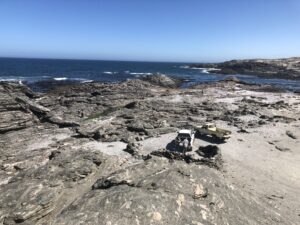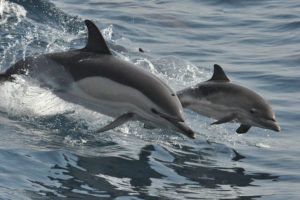About an hour after leaving the marina we noticed the boat wasn’t tracking all that well. Most cruising boats don’t actually have a person sit at the helm, but have an automatic pilot do the steering, just punch in a compass heading and off you go. Many boats also have a windvane, a very clever contraption that hangs on the stern, the back of the boat, and keeps you on a certain wind course. If the wind shifts, you shift with it. We have both, but as we are motoring we’re using the automatic pilot. And judging by the wake we leave behind that pilot seems rather intoxicated.
We opened up the lazarettes, the lockers in the cockpit, emptied them out to get to the heart of the problem. Nothing is easy to get to on a boat. And yes, the lever connecting the autopilot to the boat’s steering mechanism had two bolts sheered off. An almost impossible place to get to. What to do? Sensible people would turn back and get it repaired. But I’m thinking, we just came six miles, only about 2600 to go, we’re practically there. Dan thought it to be a pain in the butt, but is quite willing to look at it in a day or two. He somehow thinks he can get those bolt pieces out and get it working again. And we do have the windvane to keep us on course. I’ll write about the windvane at a later date, such a cool piece of equipment.
We settled quite quickly into the mundane life at sea. First we had to figure out how to run watches around the clock. Three-hour shifts, four-hour shifts, what’s the best way of doing it with only two people on board. I think four-hour shifts, Dan thinks wake the other person up when you get tired. No set time. I don’t know quite how, but we almost automatically fell into one shift from dinner until one hour past midnight and one shift from there until seven in the morning. It works. Two six-hour shifts. One of us is in bed by seven and gets up just before one. The other then goes to bed and sleeps until about seven in the morning. During the day we each take naps here and there between cooking, setting the sails, cleaning and whatever else comes up.
Twice a day we check in by radio. The Pacific Seafarers Station out of the U.S. calls us at 03:00 UTC We give them our location, barometer pressure, height and direction of waves and some other specifics. This is a totally free program you can sign up with if you have a single sideband radio (SSB). You need a ham license for that. I think it is completely run by volunteers. At 06:00 GMT we do the same with Northland Radio, a similar check-up, run by Peter out of New Zealand. It’s Peter’s hobby and he is obviously very dedicated to it. He always sounds very enthusiastic. With sat phones and other satellite communication systems such as Garmin’s inReach these days, SSB radios are slowly going the way of the Dodo. But it is still fun to use. We also have an inReach unit on board. Via satellite, or multiple satellites, I don’t really know, I can send texts to cell phones and email addresses as long as it is less than 160 characters. That service, however, comes with a hefty monthly subscription fee.
We figured 26 days from New Zealand to Tahiti. And I don’t think we’re making it. We started off so well, but the last five days or so have been the pits. At one point we couldn’t sail as the winds were too strong and the waves too big that we had to heave to, a technique that keeps you roughly in one spot with your nose just off the wind. Go below and lock her up. Throw away the key and bring out the wine. We’ve also had days of very calm seas with hardly any wind at all, doing less than sixty miles in a 24 hour period. What’s with that? And rain. And then some more rain. Seriously looking forward to the tropics.

